How to Kill Red Spider Mites On Plants: Identification, Treatment and Prevention of Spider Mite Damage
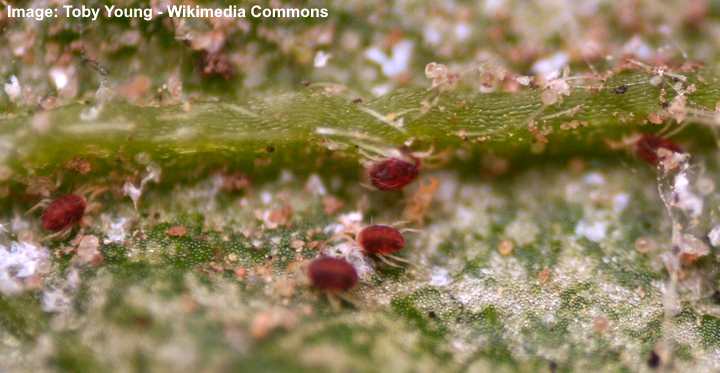
Red spider mites are tiny destructive pests that can infest indoor and outdoor plants. Red spider mites cause plant damage by spinning webs on plant foliage, feeding on plant tissue, and sucking plant sap. The tiny red pests are difficult to spot under leaves. Telltale signs of red spider mites are yellow or brown spots on leaves, webbing, and weak plant growth.
Red spider mites (Tetranychus urticae) belong to the mite family Tetranychidae. Although people refer to these houseplant pests as bugs, they are not true types of bugs. Neither are red spider mites types of insects, but they are related to spiders in the class Arachnida.
The problem with getting rid of red spider mites is that they are so difficult to spot. Also, these tiny red creatures feed on most kinds of plants and crops. A large infestation of red spider mites can be enough to kill a plant.
This article is a complete guide to the best ways to eliminate red spider mites on plants. In addition to natural remedies for eradicating these red “bugs,” you’ll learn about easy methods to prevent red spider mites from infesting your indoor plants.
What Do Red Spider Mites Look Like?

A picture showing red spider mites on a plant – the spider mites are the tiny red bugs on the sticky webs
Red spider mites (Tetranychus urticae) look like tiny red dots moving around the underside of plant leaves. Spotting these little mites is challenging as the females only measure up to 0.4 mm long—and the males are even smaller. Unfortunately, red spider mites typically become noticeable only when the infestation is extensive.
Usually, you’ll notice webbing under leaves before you’ll spot the plant-feeding pests.
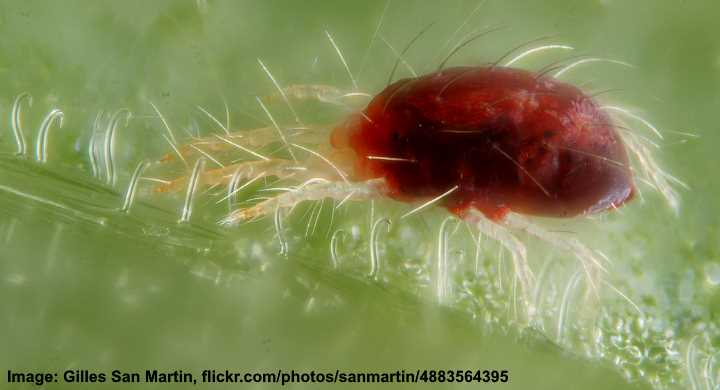
A close up picture of red spider mite (enlarged)
Looking at pictures of red spider mites, you’ll see that the plant pests have oval bodies. Similar to all types of spiders, these red mites have eight legs. Close-up pictures of mites show that they have spines sticking out from their legs. Typically, the first sign you have red spider mites is noticing webs on plant foliage and stems.
If you see tiny white, green, yellow, or brown dots moving on leaves, it could be that you’ve got regular spider mites. Like the red species, these pesky bugs also feed on plant juices and spin protective webs. You might also see red spider mite activity on the delicate silk web structures they spin.
It’s the web-spinning activity that differentiates red spider mites from other houseplant pests. For example, aphids and thrips are also tiny pests that can destroy plants. However, they don’t spin webs on plant foliage.
Red Spider Mites Life Cycle
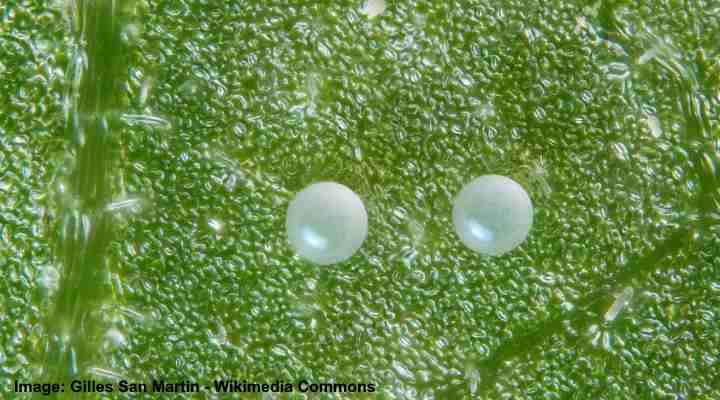
A close up image of spider mite eggs
The life cycle of red spider mites starts as tiny eggs attached to the fine webbing. After a few days, the eggs hatch into larvae. In optimal conditions, it takes between five and twenty days for red spider mites to reach maturity and complete the life cycle. Adult red spider mites live for between two and four weeks, and females can lay hundreds of eggs in that time.
The ideal breeding conditions for red spider mites to multiply are hot, dusty, and dry conditions. In these conditions, it can take less than a week to complete a generation. It’s also good to note that over-watering plants can cause stress and make the plants susceptible to red spider mite infestations.
Generally, red spider mites don’t live in the soil. Instead, red spider mites prefer to live and breed under leaves on ornamental plants, trees, and crops. Out of sight, these tiny red creatures can breed and multiply before you realize you’ve got pest problems.
Knowing the life cycle of red spider mites is key to controlling their numbers. Because they prefer dry conditions to breed, keeping the soil slightly moist and the air humid helps prevent many plant pests—including mites. So, it’s best to use the proper methods to water houseplants to avoid pest and disease problems.
How to Identify Red Spider Mites on Houseplants and Outdoor Plants

Red spider mites on a leaf underside
The best way to identify red spider mites is by looking closely for any signs of webbing under leaves. The delicate spider webs help protect eggs and larvae from predators. It’s only when their numbers become extensive will you notice many red dots crawling on leaves.
The most common place to detect red spider mite activity is between plant stems and leaf petioles. Even a few thin strands of silky web are enough to identify potential problems with mites. As the number of red spider mites increase, so will the size and density of the webs.
It’s also a good idea to be in the habit of looking for spider mite activity on plants in garden stores.
You can also check for red spider mites by putting a sheet of white paper beneath the leaves. Tap the foliage sharply, and if the plant has spider mites, you’ll see tiny reddish dots fall onto the paper. This way is easier to identify them than on green leaves.
Another way to identify red spider mites is by the damage they do to plants. Red spider mites have piercing-sucking mouthparts. They use these to penetrate plant tissue to feed on plant cells. The harm that red spider mites do results in yellowing leaves, spots on leaves, withered flowers, and leaf loss.
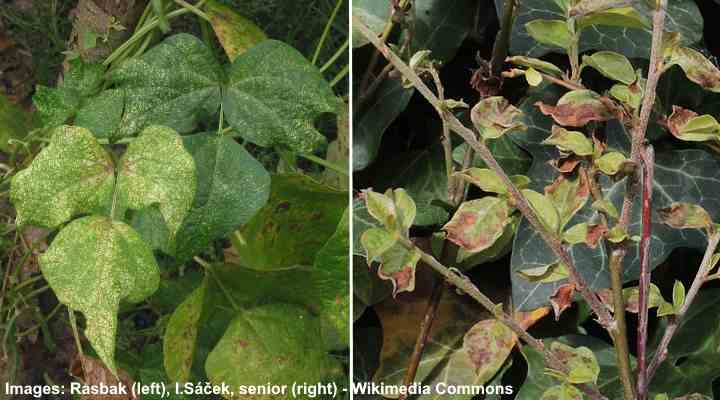
Leaf damage caused by spider mites
The only way to accurately identify red spider mites is by using a 10x or 15x hand lens to inspect plant foliage closely. Look for tiny red bug-like creatures with oval bodies and eight spiny legs. However, spider mite identification is usually easiest by examining plants for webbing and strands of fine silk dangling from stems.
Red Spider Mite Plant Damage
Red spider mites damage plants by sucking juice and plant cells from leaves. A few bugs biting into plant leaves won’t cause much damage. But red spider mite numbers can multiply quickly and affect plant growth. The first signs of red spider mite damage are light dots on leaves. Leaves then turn yellow and drop off.
Red spider mite leaf damage—Piercing and sucking plant tissue causes light yellow spots on the leaves’ upper sides. In time, leaves start to yellow and become brown as they die. Eventually, the leaves fall from the plant. Red spider mites can cause extensive harm to roses, annual plants, and most houseplants.
Red spider mite damage on crops— Apart from leaf damage, red spider mites weaken crops so much that they produce less yield. In dry, hot weather, mite damage results in low numbers of fruit and vegetables. Red spider mites infest over 200 plant species, including tomatoes, eggplant, cucumber, squash, and many greenhouse crops.
Where Do Red Spider Mites Come From?
Minuscule red spider mites can come from almost anywhere. A common way that spider mites get into homes is on new, infested plants. But the wind can blow the tiny red bugs through windows on hot, dry summer days. Or using unsterile garden soil for houseplants can result in indoor plant infestations.
How to Get Rid of Red Spider Mites on Plants
The first step in eradicating red spider mites is to isolate the plant from other houseplants. The next step is to physically remove as many of the sap-sucking mites by turning the shower on them. To help get rid of the pests for good, use a natural remedy for indoor plant pest control.
It’s best to avoid using chemical pesticides to kill spider mites. Pesticides are rarely useful for long-term solutions. What’s more, houseplant pests can develop resistance to chemicals, making them harder to remove.
With some patience and diligence, home remedies can help you rid your plants of red spider mites. Apart from being amazingly effective, natural ingredients you have in your cupboard are generally non-toxic and won’t harm family members or pets.
Here are the best ways to get rid of red spider mite infestation.
Prune Affected Leaves to Get Rid of Red Spider Mites

Get rid of red spider mites by pruning infested plant parts
Snipping off infested leaves or stems helps to remove red spider mites from the plant physically. Handle the cut foliage carefully to avoid spreading the nasty houseplant bugs to other plants. Then only discard the infested plant parts in the trash, never in your compost.
It’s good to remember that pruning is only the first step in your battle against red spider mites. You still have to treat the rest of the plant to disrupt their lifecycle and get rid of the annoying mites for good.
Unfortunately, in heavy red spider mite infestations, you may just have to cut your losses and discard the whole plant.
Shower Plants to Remove Red Spider Mites
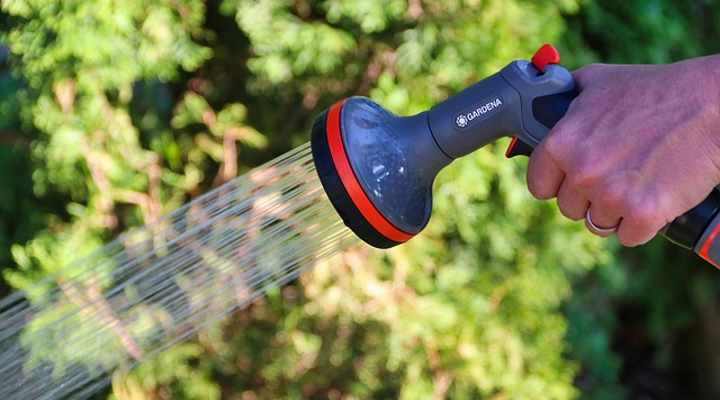
Eliminate red spider mites by hosing them
A sharp blast of water can dislodge spider mites from underneath plant foliage. All you need to do is take the affected plant to the bathroom or outdoors and rinse it with lukewarm water. You can use a similar method to control red spider mites on greenhouse crops—just turn the hose on the plants to get rid of the pests.
Use Soap Spray to Kill red Spider Mites on Plants
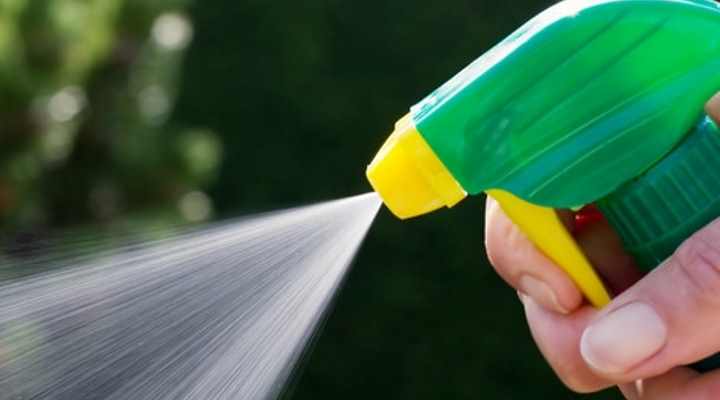
Kill red spider mites by using a soap spray
A soap and warm water spray is a quick, non-toxic way to eradicate red spider mites from plants. Put 1 tsp. Castile soap or liquid dish soap and 1 quart (1 l) of lukewarm water in a spray bottle and shake well. Thoroughly douse both sides of the plant’s foliage to kill the tiny red bugs and their larvae.
Another natural pest control method is to use a soapy solution and a sponge to wipe down the plant’s foliage. Not only will you remove mites from houseplants, but you’ll also clean the leaves and improve the houseplant’s appearance.
Soap is a mixture of oils and fatty acids that kills spider mites on contact. The soapy solution suffocates the plant bugs and penetrates their outer layer. The benefit of using soap and water for spider mites is that it’s safe around kids and pets. Organic-based soaps are also ideal for organic gardening methods.
Apart from killing spider mites, soap sprays are effective houseplant pest treatments for mealybugs, scale insects, aphids, whitefly, and thrips.
Get Rid of Red Spider Mites on Plants with Neem Oil
Use an organic neem oil solution to get rid of red spider mites for good. Mix 2 tsp. organic neem oil and 1 tsp. Castile soap with 1 quart (1 l) of warm water. Fill a spray bottle and liberally spritz both sides of the leaves to eliminate red spider mites.
Scientific researchers say that neem oil contains a natural pesticide called azadirachtin. Studies have shown that neem oil solutions are highly effective against Tetranychus urticae. In some cases, it resulted in 100 percent mortality.
The benefits of using neem oil as a natural miticide are that it’s non-toxic for humans and pets and doesn’t affect birds, worms, or other beneficial garden creatures.
Use Rubbing Alcohol to Kill Spider Mites on Plants
Wipe down infested plant foliage with 70 percent isopropyl alcohol to kill red spider mites immediately. You can also make a bug spray to destroy mites by mixing equal parts of rubbing alcohol and water. Spray the leaves with the solution and wipe with a clean cloth to remove pests.
It’s good to remember that alcohol can damage the leaves of some sensitive plants. If the alcohol affects the leaves, dilute the solution with one part alcohol and three parts water.
Rubbing alcohol is also an effective houseplant remedy for getting rid of aphids, mealybugs, and scale insects.
Vinegar Spray to Get Rid of Red Spider Mites on Houseplants
Vinegar is an acidic substance that can effectively eliminate spider mite infestations. Mix a one-quarter cup of white vinegar, one tablespoon baking soda, and a few drops of Castile soap with 1 quart (1 l) lukewarm water. Combine the ingredients in a spray bottle and spray on plants showing signs of spider mites.
Rosemary Oil Spray to Eliminate Red Spider Mites from Indoor Plants
Use a rosemary extract spray as a natural insecticide against red spider mites. Fill a spray bottle with warm water and add one teaspoon rosemary essential oil. Shake well to mix the ingredients and spray liberally on plant foliage to kill off red spider mites.
Alternatively, you can dip a cotton wool ball in the rosemary solution. Wipe both sides of the plant leaves with the natural miticide to reduce the number of red spider mites on plants.
One scientific study found that rosemary oil to be an effective pesticide against species of Tetranychidae. Scientists reported that a rosemary solution is suitable for “small-scale integrated pest control programs for controlling two-spotted mites.”
Biological Insecticides to Eradicate Red Spider Mites
Biological insecticides can reduce the number of red spider mites (Tetranychus urticae) that infest edible greenhouse plants. One university study found that treating tomato plants with Beauveria bassiana—a natural soil fungus—helped kill off two-spotted spider mites.
Release Beneficial Insects To kill Red Spider Mites on Outdoor Plants
Use predatory insects to control red spider mite infestations in hot, dry places such as greenhouses or summer gardens. Predatory mites, ladybugs, or lacewings feed on pests such as spider mites. The University of California says that you need about one predatory insect for every ten spider mites if you want to eradicate them effectively.
How to Prevent Red Spider Mites on Plants
Preventing spider mite infestations is more straightforward than getting rid of them. It’s vital to grow houseplants in optimal conditions and water them appropriately. Moist soil, average to high humidity, and regularly wiping leaves help prevent populations of red spider mites from flourishing.
Here are some more handy tips for spider mite prevention on houseplants:
Thoroughly check new houseplants for signs of red spider mites
Carefully inspect any plant for webbing or dangling silky threads before bringing new plants home. Also, leaf spots, yellowing, and wrinkling can be signs of many houseplant pests, including red spider mites.
If you keep some houseplants outdoors in summer, you should also inspect them for bugs, soil gnats, or other creepy crawlies.
Isolate new houseplants to prevent red spider mite infestations
As a rule, isolate any new plants in your home. Red spider eggs and larvae are microscopic and almost impossible to detect. Also, aphids, thrips, and other bugs could be lurking in plant foliage. Isolating plants for two weeks allows you to observe any bug activity and take appropriate action.
Protect plants from direct sunlight and hot temperatures
Keep houseplants out of excessive heat and direct sunlight to prevent red spider mites from thriving. Red spider mites multiply rapidly on dry leaves and hot temperatures. If possible, keep plants away from direct sunlight by placing them behind sheer curtains. This type of plant care protects the leaves and helps to prevent red spider mites.
Wipe plant leaves regularly to remove red spider mites
Regularly wipe houseplant plant foliage with a damp cloth to keep leaves humid and prevent red spider mites. Not only does wiping leaves remove spider mites, but you’ll also clean dust from foliage that boosts photosynthesis and improves plant health.
Keep humidity high to prevent red spider mites on houseplants
Spider mites tend to stay clear of humid environments. Also, many tropical plants need higher than average humidity for healthy growth. Some easy ways to increase humidity include placing houseplant pots on a pebble and water tray, misting leaves regularly, and wiping leaves with a damp cloth.
Related articles:
